Chapters
Chapter 10. Modern Publishing Transformations
Libraries, globalization, corporatization, and artists’ publications
By the beginning of the 20th century, books, mass circulation magazines, newspapers and other forms of print production had exploded. In the era just before cinema and radio appeared, print was the mass medium par excellence. Niche publications for every sector of the market had appeared. With them came new business and advertising models. Literacy rates in the developed world were higher than at any point in history, and compulsory education ensured children would acquire the rudiments of reading and writing.1 Crucial developments took place as public library movements caught on in Great Britain and the United States, along with other models of subscription and shared circulation of printed materials.2 Censorship laws continued to change and milestone rulings on obscenity, artistic merit, and freedom of the press were produced in response to changing attitudes.3
The range of production methods stretched from the finest, highly rarified and limited editioned works to relatively cheap and inexpensively produced materials, but the advent of photo-offset printing introduced another dimension to production. Not only were photographs being reproduced in an affordable, mechanical, manner for the first time—and finding their way into magazines, journals, books, and newspapers—but photographic methods of reproduction allowed for facsimile and reprint of pre-existing material—visual and textual—to an unprecedented degree.4 Artists as well as traditional publishers took full advantage of these changes, seizing the opportunity to create artist-initiated publications across a wide spectrum of aesthetic positions.
Meanwhile, the publishing industry, once-dominated by large family-run firms, gradually shifted towards corporate models with increasing consolidation in the field.5 By the start of the 21st century, publishing worldwide was largely controlled by a handful of mega-corporations whose interests included television, media, film, newspapers, as well as publishing. To some, this signaled the narrowing of the publishing field, even though alternative, small press, street publications and other outlets of individual and community expression flourished. Technological innovations at the end of the 20th century introduced yet another wave of radical change in the production and distribution of materials through the networked infrastructure of digital tools and platforms.
Print innovations
Around 1904, offset printing and the photo-halftone were invented (somewhat accidentally) in the United State by Ira Rubel.6 Offset was a modification of lithography, a planographic technique, but it used thin metal plates rather than limestone, and a process of transfer of the image from the plate to a rubber blanket from which it was “offset” onto paper.7 The quality of image reproduction, and type for that matter, became more refined in tone and line. Photo-offset made use of half-tone screens, themselves marvels of modern graphical engineering. These translated continuous tone materials, such as original photographs or artwork, into discrete values that could be printed in a single color but produce the illusion of tone. Digital output also makes use of halftone screens, and computer pre-press work done for offset must still take halftones into account. The industry of mass circulation magazines and color printing depended on offset, though many publishing companies that had invested in their own printing equipment or plants remained committed to relief printing until quite late in the 20th century and used linotype and stereotypes because the costs of refitting their printing plants were not deemed worth the investment.
Offset printing was integrated into automated presses. The flexible metal plates and soft rubber blankets (for transfer) fit onto cylinders that could be used on presses capable of printing a single color or a whole series of what are known as “process” colors. These created the illusion of full color with a combination of four inks (magneta, yellow, blue, and black) in what is known as CYMK. Features like metallic ink or lacquer could be added as special effects. Color gravure printing, introduced at about the same time (around 1906) was a competing technology. It made use of intaglio methods on engraved plates that became popular with newspaper publishers. The color sections of newspapers quickly became the most read parts of the paper, and thus sought after by advertisers as well as used for their editorial content. Society pages, reports on events, and other features with engaging visual interest became associated with the “Rotogravure” section.8 Comics had been printed in color occasionally in the 1890s. But in the early 1900s, color sections of vivid, now classic, strips like Winsor McKay’s Little Nemo in Slumberland, gained loyal followers.9 These strips were characterized by reflections on American life and their original and striking graphic imagination. Rotogravure was used on a mass scale from the 1930s through the 1960s, with major impact on magazine publication and photojournalism as well as illustration. Color printing was a boon to children’s books and the juvenile market in general. But literary production for adult readers distinguished itself by becoming typographic. The adult illustrated novels of the 19th century gave way to textual editions devoid of imagery, except for cover designs in the paperback market.
Typesetting went through several technological changes in the 20th century, moving from hot type (hand set metal) to phototype (known as cold type because it was not cast in lead).10 New flexibility came with the new technology, as photographic means could be used to stretch, bend, overlay and otherwise alter traditional letterforms. Phototype, like lead type, was still handled by professional shops, but by the 1970s, the first generation of typesetting equipment put phototype and simple electronic machines into an affordable format. This equipment could be integrated into a small publishing house or print-shop.
In the 1980s, when desktop computers became available, typesetting and layout programs were among the first commercially available software packages. Once esoteric, professional trade terms like “leading” or “font” became commonplace. Designers created typographic innovations meant for the pixel, raster, and vector-based output of digital driven printers. The layering of image and text, their treatment on the screen and page, changed dramatically. Again, this effect was felt more in journals in the 1980s (Wired magazine and Raygun were striking examples), where the work of adventurous and creative designers defined a new language of graphics from computational methods.11 The conceptualization of print artifacts in page description formats added a dimension to design practice that has theoretical aspects as well as practical implications. But the main impact of digitization was to make it possible for the technical suite of once-professional skills—from the design of type to entire books—to become widely available on personal computers in widespread business, educational, and domestic use. The categories of reader, writer, designer, publisher, and producer could blur.
Bookstore circulation and Public Libraries
The increases in book production and readership that are steadily marked through the 20th and 21st centuries were supported by changes in literacy, but also, new modes of access. In the 17th century, the university town of Manchester, England, actually created the first public library in the English-speaking world.12 Chetham’s Library was founded in 1653, and remains in operation with an eclectic combination of manuscripts, deeds, books, magic lantern slides, and other collections. Another early library also came about as the result of a bequest, when Captain Robert Keayne left his book collection to the town of Boston in 1656.13 These were anomalies, special cases rather than harbingers of a movement. Parish libraries, inspired by Thomas Bray, an Anglican priest, were established a little more systematically in the late 17th century, providing reading materials for lay and religious members of the community in the American colonies.14 Benjamin Franklin’s still extant Library Company was first opened in 1731 and offered membership subscriptions to support its operations.15
In the 18th century, lending libraries and subscription libraries became commercial concerns supported by publishers and booksellers (happy to circulate extra copies for a fee).16 By 1800, more than a thousand lending libraries were operating in Britain with collections ranging from 200 to 20,000 volumes. The link with publication helped foster changes in authorship—for instance many women writers gained visibility within this system. Women readers were a large constituency, especially for novels, which were conceived to have a short shelf-life and were not generally kept for reference or reflection. The Minerva Press Circulating Library, associated with publisher John Lane, was a pioneer in conceiving of a “franchise” model in which stock was supplied for branches.17 Mudie’s Select and W.H. Smith (preserved as a contemporary bookstore chain), not only supplied books, but spaces in which it was considered acceptable for women to gather and read.18 These social changes demonstrate that literacy and culture are interlinked in ways that are not limited to the mere production of books, but to the cultural patterns of their consumption.
The public library movement fostered access and spaces outside the home for study and exchange of ideas. The Public Libraries Act was passed in Britain in 1850, and by the 1890s, mobile library services were also begun in Britain.19 Taxes raised in support of public libraries created new institutions throughout North America and Britain in the 19th century, with momentum developing rapidly. But American libraries were changed dramatically through the philanthropy of Andrew Carnegie, who in the seventeen years between 1900 and 1917 endowed more than 1700 libraries (roughly a hundred a year) in towns and cities across the United States.20 Though local municipalities were responsible for raising the funds for operations and collections, building Carnegie libraries added prestige and legitimacy to many small towns. Libraries were segregated in the American south, and African-Americans were denied access until the 1960s. But interestingly, libraries were integrated before schools.
The global book trade, supported by international copyright laws, changes in the costs of production and distribution of books, also resulted in the creation of highly distinguished collections of antiquarian materials. The half dozen greatest private library collections in America were all put together from purchases acquired beginning in the 1890s. This is remarkable, considering that in each case these libraries began without legacy materials on which to build. Known by the names of their original founders, the Huntington, Folger, Morgan, Ransom, Clark, and Carnegie libraries were private, not institutional. So, unlike the great university libraries of the world, these were collections created through individual passion and drive, but also, through the work of learned book dealers and antiquarians capable of assisting collection development at a major scale. While most of these collections dealt in rare books, historical materials, some patrons, like the French collector Jacques Doucet, also supported aspiring writers and publishers through subventions. William Andrews Clark Jr. provided work for a number of California fine press printers, most notably John Henry Nash, by commissioning editions.21 Doucet, by contrast, paid young Surrealist authors for their work, thus amassing a unique collection of original manuscripts in the 1920s and 30s. Today these great collections provide another dimension of access that complements the great university and state libraries, bringing a collector’s vision and passion to the shape of their holdings.
The social dimensions of reading were enhanced by formation of book clubs, which became popular in the 1920s and increased steadily across the decades.22 Oprah Winfrey’s Book Club, whose members number in the millions, is the most popular contemporary extension of these early organizations, and obviously takes advantage of broadcast mass media as well as networked environments to foster readership.
Bookstores also changed, leaving their activities as copyists and/or publishers far behind. The typical British or American booksellers of the 19th century managed inventory stored on closed shelves.23 Operated independently, they catered to a local clientele (or, as in the case of the railway station stores, a transient one). Open shelving first appeared in a widespread way in the 1920s and 30s, and allowed for browsing among offerings. In the 1980s, the trend to book-selling superstores and national/international chains skewed market conditions.24 Barnes and Noble, one of the most visible of these chains, worked like other large-scale corporate entities in the entertainment and media business, to acquire existing competition through buying such established named brands as B. Dalton. Expansion of Barnes and Noble, in North America, made competition from independent book stores difficult, since the costs of buying in bulk, deals with publishers, and even pressure on publishers to produce titles the chain knew would sell, had economic effects. The costs of maintaining the stores and building them to brand specifications was considerable, and as Amazon came online, its capacity to operate without the so-called “bricks and mortar” overhead pressured the superstores, putting many of them out of business in turn. These models of corporate conglomeration were operating in the publishing world as well as that of booksellers, and independent presses, like small bookstores, continued to operate, but in very tight margins of profit. Paradoxically, the vanishing Barnes and Noble shops that were once considered anathema to many, were mourned as these stores closed in malls and urban centers. With their children’s corners, coffee shops (usually another chain), and wide inventory across every genre from self-help to computers, recipe books and travel guides, science fiction, literary and genre works, reference books and selected non-fiction, they had become pseudo-public spaces for reading.
Intellectual property
When the first Statutes of Anne were passed in the early 18th century, their protections were meant for publishers as well as authors, and had been developed in part to fill the gap created by the end of the Stationers’ ability to rely on the Licensing Acts to control publishing.25 The idea that authors had a right to the intellectual property generated by their work developed slowly, but by the 19th century it was well established in legal and cultural terms. Authorship, even celebrity authorship, was a phenomenon in antiquity and Greek poets and dramatists, like their later Roman counterparts, gained status through the work of original composition.26 Authorial identity was attached to many works of medieval literature, as well as work brought into English through translation. This included famous texts in medicine, astronomy, geometry, alchemy, and other fields of expertise, as well as poetry, drama, travel narratives (fictional and real), and so on. But the concept of the individual intellectual property, and of a specific text (copyright does not protect ideas, only their expression), grew alongside celebrity culture in other domains. Authorship provided fame, influence, and, sometimes but not always, income. Eighteenth-century battles over the terms of copyright pitted bookseller/publishers, who wanted to retain copyright into perpetuity once it was granted, and those who advocated return of rights to authors after a limited term, and those who believed in public domain and access to intellectual materials.27 These battles were accompanied by rhetoric promoting access to knowledge, and were ultimately decided in legal terms which invoked the notion of a public domain for all works put into print before the Statutes of Anne were originally enacted.
Copyright law was created and passed independently in the American colonies, and then kept in the young nation. Terms of about 14 years assigned the rights to authors for their publications.28 Once the term expired, materials went into public domain. International agreements about copyright were essential for protecting authors and publishers from pirated editions, but no coordinated agreements existed until the Berne Convention.29 Held in 1886, it committed signatory nations to mutual agreement on the terms of copyright with agreement to respect its application across borders. The Convention was particularly focused on literary work, with the result that the enormously profitable business in transatlantic production of unprotected editions came under control. For authors, this was a major triumph, as it was for publishers negotiating publication and distribution across national boundaries. By 2012, there were about a hundred and seventy participating nations, with most of the world committed to some kind of shared copyright protection (nations still not listed as participants include Iran, Iraq, Myanmar, Ethiopia, Somalia, and Angola among others). The Convention had been inspired by the author Victor Hugo, a prolific French novelist who had first-hand experience with the negative impacts of piracy. By contrast, Dutch publishers, who had profited from illegal publishing, initially protested its terms.
As authorship became ownership of a brand, the marketing of a celebrity identity gave rise to its own subsidiary industries, particularly those fostered by literary agents and authors’ societies. Literary agents first appeared in the late 19th century, but by the 1920s, they were helping authors negotiate for over twenty-six different rights in publication—for product tie-ins on cigarette cards and other advertising, as well as rights for films and other media adaptations.30 Though United States had nominally committed to the Berne Convention, the terms of its protections were only slowly adopted (and not universally). Authors and booksellers continued to advocate for rights, thought they were not always completely aligned with each other’s causes. In 1883, an American Copyright League was founded as an advocacy group and sponsored public readings by prominent authors in support of the cause, which gradually gained ground. The 1891 International Copyright Law, however, had been strongly supported by prominent American writers such as Mark Twain and Louisa May Alcott, who, like their French counterpart, Victor Hugo, saw the benefit of these international protections.
The networked conditions of distribution of literary property have changed some of the fundamental principles on which copyright has functioned. For instance, in the traditional concept of “first sale,” a purchaser becomes the owner of the object, usually a book, tape, record, disk, in which the intellectual property is instantiated. This object can then be resold, shared, given away without any return to the original publisher or author. Many digital business models are grounded in a licensing agreement that does not allow such secondary resale or sharing. Copyright law continues to evolve, and the role of corporate producers of intellectual property has had a large impact in this area. In several crucial cases, the Disney corporation has succeeded in extending the length of time a work can remain in copyright. In addition, corporate entities can be considered “authors” for this purpose.31 These rulings are seen by many as extremely damaging to the proliferation of knowledge and at odds with principles of access to the cultural record that were key impulses behind the Statutes of Anne three hundred years ago. The roles of libraries and librarians are affected by these issues, since the terms on which materials may be made available is subject to legal statutes and economic limitations that may not always appear to be in the best interest of the public or educators.
Bestsellers to Blockbusters
Print production has continued to expand exponentially, and the estimates of the numbers of books in print in the 20th century and beyond are staggering. The range of texts continues to cover a broad spectrum. Fiction was a staple of the publishing industry when the 20th century began. In the mid-19th century, a substantial portion of titles being published were religious (about 20%), but by the mid-20th century, this had dropped to 5% (though it should be noted that the Bible and Qu’ran are among the bestselling books of all time, with an estimated 5 billion copies of the bible believed to have been printed in the last two centuries and a little less than a sixth that number of copies of the Qu’ran issued, around 800 million) .32
The 1920s are considered the great Modern Age of American literature. Though 19th-century American authors had achieved international acclaim earlier, such as Twain and Alcott, mentioned above, but also Walt Whitman, Edgar Allen Poe, Harriet Beecher Stowe, and Ralph Waldo Emerson among others, the growth in the American publishing industry helped support and promote American writers in the 20th century.33 The family houses, founded and controlled by individual editorial vision, were often conceived with a high commitment to literary values—even if these did not necessarily translate into economic success. This attitude, that literary work should come into print, even if other publishing activity had to be mounted to support it, directed the view of Simon & Schuster, Random House, Alfred A. Knopf, Viking, Scribner’s, Boni and Liveright, and others. They published cutting-edge literary texts by Ernest Hemingway, Thomas Wolfe, F. Scott Fitzgerald, Eudora Welty, William Faulkner and other major figures of American literature. The notion of the bestseller existed, but it was not the exclusive criterion on which publishing decisions were made.
By the late 20th century, the dominance of bestsellers coincided with the growth of chain bookstores, eager to stock “sure” sellers.34 The range of materials available in print shifted in the 1980s and 1990s, as many publishers started shrinking what were known in the trade as the “mid-list”—books that sold well but were not bestsellers. Between 1986 and 1996, the bestseller market was dominated by five authors: James Clancy, Danielle Steele, John Grisham, Stephen King, and Dean Koontz, who accounted for 63 of the 100 bestsellers of the period. But surprises are still possible, and the unprecedented success of the Harry Potter series, which sold more than 400 million copies over the seven-volume publication, made its author J.K. Rowling the most financially successful writer in history. Other works also sold astonishingly well in the same period, Winnie the Pooh 70 million, Lord of the Rings 150 million, and over the course of its hundred-and-fifty-year history, A Tale of Two Cities (first published in 1859) is believed to have been published in about 200 million copies.
Paperback publishing went through an enormous change in the 20th century as well. While novels had been issued in soft paper covers in the 19th century, the paperback constituted a new genre of literature, associated with pulp and popular titles, many of them accompanied by lurid covers and (sometimes but not always) equally sensational writings. The use of cheap paper made from wood pulp gave the books their name, but the covers were masterworks of popular illustration.35 These books flourished from the late 1890s through the 1950s. Some were serial fiction, some were adventure stories aimed at boys, or titillating tales meant for men. With titles like Spicy Adventure Stories, Weird Tales, or Amazing Adventures and other suggestive names, the books used their cover art to attract readers paying 10 cents or so a copy (hence the use of the term, “dime novels”). Interestingly, many well-respected writers got their start in pulp venues, such as Raymond Chandler and Dashiell Hammett, and for science fiction, apprenticeship in the pulp market was almost a requirement for establishing credibility. Romance writing was a favored genre as well, with the formulaic and well-established bodice-rippers and “historical” fiction catering mainly to female audiences. Covert and somewhat coded homosexual fiction also found a place in the pulp market, as did the portrayal of drug culture. Many classic and canonical novels were published in pulp formats. Salacious book covers produced to make Romeo and Juliet or Tess of the D’Urbervilles look like racy literature can be amusing. [Figure 1]
Those concerned with the future of publishing worry that the trends in the business work against the publication of innovative and literary work, or work that caters to alternative thought.36 Small presses and independent publishers supply some of the titles for these domains, but distribution and visibility remain a problem when contrasted with the resources brought by mega-corporations to place copies of bestsellers into every airport newsstand in the world. The homogenization of culture is one concern, with its insidious and not always visible control of values and its normative attitudes towards gender roles, family life, wealth, work, and other matters.
By the start of the 21st century, the family-owned publishing houses were almost entirely absorbed into multi-national corporations. The history of absorption, mergers, and acquisitions reads like a big-fish-eat-little-fish tale in which identities and individual editorial positions are increasingly subjected to corporate bottom lines. To track one such example, Random House, which was first established in 1927 by two partners, Bennett Cerf and Donald Klopfer (for books they picked “at random”).37 They acquired the prestigious Modern Library and issued books in that series with an imprint designed by the prestigious American artist, Rockwell Kent. Random House generated the revenue to support more adventurous (less well-paying) titles, by publishing reference texts. The indispensible American College Dictionary was first published in 1947, as college enrollments were being boosted by the GI bill. Unprecedented numbers of students were able to afford and attend college as the first generation in their families and such texts were essential elements for their studies. But in the mid-1960s, Random House was acquired by the media company, RCA (Radio Corporation of American), which then went on to acquire Ballantine Books. The company continued to grow by acquiring Fawcett Books, Times Books, Fodors, Crown, Harmony, Chatto, Bodley Head, Jonathan Cape and other renowned publishers with their own established client base and backlog inventories. In 1998 the conglomerate was itself absorbed into Bertelsmann, the enormous German firm, one of the “Big Six” international media companies, of which CBS, Hachette, NewsCorp, Pearson, and Verlaggesgruppe are the others. What this will mean for the future of publishing, culture, literary life, and individual expression remains to be seen. [Figure 2][Figure 3]
Issues of censorship and boundaries of control were also contested in the 20th century. Politically motivated censorship did not abate. Book burnings, particularly in Germany during the rise of National Socialism (the Nazi party) were public spectacles beginning in 1933, as Hitler rose to power.38 The Catholic Church continued to issue its Index of prohibited books until 1948 and only abolished its existence in 1966. The terms on which censorship was warranted by Church officials included any hint of heresy, occult materials, satanic or magical texts, and works whose moral values went against the teachings and commandments of the church.39 While the inclusion of titles by many Enlightenment philosophers (Denis Diderot, Jean-Jacques Rousseau, the Baron de Montesquieu, etc. ) may not be surprising, nor that of such libertines as Casanova or the adventurous Marquis de Sade, the novels of Émile Zola, Victor Hugo, Gustave Flaubert and Daniel Defoe are more so. Other frequently challenged books have included Maurice Sendak’s Where the Wild Things Are, Martin Hanford’s Where’s Waldo, and books attempting to normalize non-traditional families, such as Leslea Newman’s Heather Has Two Mommies. School reading lists and libraries are particularly vulnerable to special interest groups wanting to promote particular ideological agendas. Political censorship has been used by many repressive regimes as an instrument for controlling language and the dissemination of ideas. This was true of monarchical licensing techniques, which subjected texts to pre-publication review and approval. It became true of Soviet Russia, East Germany, Maoist China, and other governments that imposed sanctions, prison sentences, fines, and other punishments on offenders. Controlling access to the means of production is one effective method of censorship, though it can backfire. It spawned, rather than stopped, the Samizdat groups who used typewriters and handwriting to circulate manuscripts among dissident or literary circles. The handmade look of their work helped codify its appearance and authenticity. The systematic destruction of libraries has a painfully long history, and continued in the 20th century. The facts about and images of Nazi book burnings are particularly familiar and vivid examples. But the history of Soviet occupation of Eastern bloc nations contains a decades’ long record of bibliocide. Not only are materials destroyed, mounted into public pyres and burnt, but the systematic elimination of languages has also been engineered as repressive measure in various political struggles of the 20th century. By banning Albanian in 1991, the Serbian government was imposing a particularly pernicious method of ethnic cleansing.40 In a perverse way, one can construe the creation of elaborate propaganda machines spewing out their state-manufactured rhetoric as another form of censorship since such printed matter takes up the space of discourse in culture and impoverishes debate and dialogue by removing the language with which to speak of certain struggles. The South African government banned signs and symbols of the African National Congress, effectively rendering them invisible in media terms.41 Freedoms from censorship cannot be glibly attributed to democratic regimes, however, as there are instances of political repression in American culture and other western nations. In some contemporary countries, criticism of a ruling monarch is prohibited, as is mockery of a foreign ruler, even if celebrated support of materials censored elsewhere, such as the famous case of Salmon Rushdie’s Satanic Verses (1988), attests to apparent commitment to free speech.42 The work of reformers trying to purge literature of the attitudes of the past that are currently found reprehensible—such as racist stereotypes and ethic slurs—often misses the point that explanation and engagement, rather than elimination, serve to bring awareness of changing values to the fore. Censorship for obscenity has its own history, not always independent of political trends, but often pursued on other grounds. The tests for obscenity have varied, and tend to engage issues of local mores, community values, and reception.43 The idea of protecting public morals from negative influences that might corrupt or deprave a population is somewhat different from the idea of policing political speech that might inflame people to action in the name of anti-establishment beliefs. But they share a notion that transgression must be controlled in the name of some higher cultural good, thus implying that published work has a real power to affect readers. As with the temperance (anti-alcohol) movements that arose in the late 19th and then 20th century, the advocacy against “bawdy” literature came from high-minded progressives. The Comstock act, passed in 1873, made use of postal laws to destroy or prosecute obscene materials.44 The difficulty of defining obscenity is linked to local constituencies and imagined readerships. In the United States, laws became increasingly strict, so that works put into print in the 1950s had to meet a standard of being safe for juvenile, as well as adult readers. This extreme was gradually lightened. As sexual mores loosened in the 1960s, so did bans on film, images, and works that were considered to have artistic or scientific significance. James Joyce's Ulysses was subject to a famous attack in an accusation that suggested the language in the book was “unparlorlike,” and potentially subversive to many “cherished moral, religious, and political beliefs.” John M. Woolsey, the judge who passed the final ruling, disagreed.45 He stated that it did not contain “the leer of the sensualist” and furthermore, stated most poetically, that “it must always be remembered that his locale was Celtic and his season Spring.” [Figure 4][Figure 5]
Most significantly, in the late 1960s, the Supreme Court failed to uphold lower court rulings that possession of possibly obscene material was a crime, thus protecting the right to read, view, and even purchase materials that might be deemed offensive to some portion of the population.46 Understandably, child pornography is not protected by this ruling. The debates about pornography control and censorship have shifted as the definition of “local community” has changed in the networked Web. Material produced in one cultural location can be deemed offensive when received in another, and vice versa. Geographically distributed by temporally synchronous, their distribution faces new challenges over jurisdictional rulings. The influence of the Arts and Crafts movement and the related fine press movement of the last decade of the 19th century continued into the early years of the 20th in the design, content, and generally sensibility of aesthetic book production in North American, Europe, the British Isles, and Russia, as well as other portions of the globe. Artists and publishers, keen on producing well-made objects for a market of consumers with fine taste, created books and publications across a range of formats.47 Books made by the fine presses that followed in the pattern of the Arts and Crafts movement were one continuing style of publication. But they were a long way from those that were created to fit new conceptual frameworks that emerged in the early 20th century. These included the newly formulated livre d’artiste and the radically different early avant-garde.48 What these formats had in common was their commitment to the production of books as primary works of art. Artists from the Renaissance onward (and within traditions of illumination) had certainly seen themselves as making aesthetic works. Renaissance artists in the 15th and early 16th centuries, like Geoffroy Tory, Anton Koberger, Aldus Manutius and many others, were well aware of books as a form of expression whose details of design and production factored into their meaning. But the artists of the 20th century who took up book production as a mode of aesthetic expression and individual voice conceived of their work within the frames of fine arts as well as mass media. They were using books as platforms for protest as well as for personal expression, sometimes in striking opposition to the notion of consumable commodities. Artists' book production in the 20th century has often to intensify the contrast between the high-end luxury book and the artist’s initiated multiple, even if commonalities between them are evident as well (both are concerned with making books as primary works of art). The livre d’artiste, translated literally as the “book of an artist,” was originally conceived by print publishers, and dealers, in the early decades of the 20th century. Two figures in particular stand out, and help define the field: Ambrose Vollard and Daniel Kahnweiler.49 Both were actively engaged in the promotion, production, and distribution of modern art. Vollard was a dealer who helped legitimize many of the most radical modern artists in a period when the post-Impressionists like Paul Cézanne, Van Gogh, Paul Gaugin and others were still unrecognized. In 1900, he commissioned a work using pink pastel chalk drawings by Pierre Bonnard to accompany a poetic text by the recently deceased poet Paul Verlaine. The book, Parallèment, loosened the structure of the illustrations from the plate-based illustrations of 19th-century fiction, and instead, let the images work on the page as if they were prints with the text inset. This was a radical gesture, in design terms, and the drawings were produced as lithographs in rose colored ink. The effect was suggestive and unusual. Vollard saw this as an opportunity to produce print materials for a secondary market in visual art, and his interest in such printed work led him to invite Pablo Picasso to create a suite of 100 etchings. Daniel Kahnweiler was a German-born dealer whose projects in the art world included his first book, a 1909 publication of a poem by Guillaume Apollinaire with images by painter André Derain.50 These works were carefully edited and curated, and they were produced in the best studios and print shops in Paris. The deluxe outcome was somewhere between a book and a portfolio, and, as time went on, binding was often left aside so the images and sheets could breathe more easily within their portfolios or wrappers. The first project on which Kahnweiler engaged Picasso, in the years 1909-10 (when Picasso was not yet famous and was in fact struggling financially as well as personally), was to create images for a poem of the writer Max Jacob.51 Other projects followed. Throughout the 20th century, this model of publishing developed major practitioners and sponsors. The Swiss dealer and publisher, Albert Skira, the American Crown Point Press, the British Circle Press, and Iliazd’s 41 Degrees in France, were among many other major figures making deluxe editions.52 Many used classic texts, but some combined contemporary artists and newly written texts. The works produced in this vein provided a space for experimentation on the part of painters who might not have considered printmaking within their purview, nor considered books as a form for visual expression. The format of the livre d’artiste became well-established, with its adherence to printmaking protocols (thick paper, wide margins, and separation of text and image into alternating pages), and usually produced in portfolio format rather than bound editions. Perhaps one of the most striking examples of such a project was conceived in a digital mode, Agrippa, written by cyberpunk author William Gibson, with artist Dennis Ashbaugh, published in 1992 by Kevin Begos, was created in a deluxe edition that erased itself upon being read.53[Figure 6]
By contrast, the work that emerged in the early 20th century avant-garde has as much in common with advertising and mass circulation magazines as it did with the upscale ateliers and print shops used by the producers of livres d’artistes. The first major publication of a 20th century manifesto appeared in the pages of a mass-circulation newspaper, the French Le Figaro, on an April morning in 1909.54 The text was the result of an all-night revel of companions led by the Italian Filippo Marinetti. His text, which describe a delirium induced by riding in a sports car (an extremely rare occurrence for the time) and being dazzled by electric lights (also still a novelty) and enjoying sensations of speed and mechanization led him to declare that a new aesthetic must be born to suit the new age. For Marinetti and his Futurist colleagues, this meant making a direct attack on the florid, over-decorated, and now old-fashioned seeming work of the Arts and Crafts books, as well as on the language of Symbolist poets who invoked angels, other worlds, dreams, and other mythical and mystically charged concepts in their imagery. The first publications that the Futurists brought forth made use of mathematical symbols in place of punctuation, got rid of organic motifs, and embraced a publicity-driven and mechanistically flavored language of the new and the now. Marinetti’s 1914 Zang Tuum Tumb, a poem about a battle in Adrianopoli, Italy, was filled with images of bombs, the sounds of mechanization, the noise of battle, and typographic scoring that was far from the florid designs of Morris and the humanist sensibilities of Bruce Rogers, Frederic Goudy, and others. Radical in the extreme, the work made no compromises with its appearance or its attacks on the sensibilities of the bourgeoisie towards whom it was aimed. By the time that Words in Liberty, the main compendium of Italian futurist dynamic poems, appeared in print in 1919, Italian Futurism had been eclipsed by Russian avant-garde work and also Dada activity, but the book and its plates remain milestones of invention without precedent.55 Though few innovative full book-length works were created by the Italian Futurists, the Russian artists of the 1910s and 1920s, in the periods leading up to and following the First World War and the Russian Revolution, were avid and prolific makers of independently conceived and executed book works. These Russian artists were working in a context where the decisive break with European influences, long considered the height of aesthetic refinement, was crucial. The two major figures, Mikhail Larionov and Natalia Goncharova, both European-trained painters in the post-Impressionist mode, had each moved towards innovative aesthetic positions in the first decade of the 20th century.56 Goncharova discovered the Russian lubok or woodcut books that had been used to communicate religious tales and folk materials. Keen to recover an authentic Russian folk visual culture (as a way to distance herself from European models and training), she gravitated to these images and began to incorporate them into her own work. Meanwhile, Larionov shifted to a form of abstraction for which he coined the term Rayonism, in which the refracting rays of light were the main force in visual experience. Their influence and presence was met with equally strong poetic impulses from Vladimir Mayakovsky, Alexi Krutchenyk and Velimir Khlebnikov, to name just a few of the many vital figures active in the pre-WWI Russian avant garde.57 Women featured largely in this scene, and artists Varava Stepanova and Olga Rozanova were visible presences as painters and also graphic artists. Book production was done cheaply, often by the artists themselves, working at their kitchen tables with scissors, pencils, glue pots, and printed paper. Many of these books were mere pamphlets, stapled sheets created to circulate rapidly and without the mediation of publishers. These were as different in production values from the works of the editor/publishers of livres d’artistes as can be imagined. The poetry and language of the works was equally rough, direct, and confrontational. A Game in Hell was a text by Kruchenyk and Khlebnikov illustrated by Goncharova, and other titles, like A Trap for Judges (1913) or A Slap in the Face of Public Taste (1917), were clear statements of the anti-establishment attitudes of their authors.58 Through the 1910s, these works created an oppositional tone, but the events of WWI and then the Russian Revolution changed the circumstances for artists and poets. By the 1920s, a more formal, Constructivist, graphic style had come into play. Some of the artists/designers were part of international conversations about the future of art and design, trying to codify their practice into systems that could be taught as well as practiced. Among these was Lazar El Lissitzky, who had contact with European artists who were also trying to push graphic design forward in the 1920s.59 Lissitzky’s 1923 For the Voice, a design of the poem by Vladimir Mayakovsky, remains a milestone work of modern graphics, as well as a crucial book work made outside of mainstream channels of publication.60 Throughout the mid 1910s, the artists associated with the Dada movement, founded first in Zurich in 1916, and then extended to an international network, created posters, ephemera, journals, and other publications that integrated typographic approaches from publicity into their poetic works.61 The Dada journal publications from 1916-17 were conceived by Tristan Tzara and Hugo Ball, among others. Kurt Schwitters created his Merz publications for ten years, beginning in 1923, and published his famous Ursonate in 1932.62 Meanwhile, the Surrealist movement had started to form under the leadership of André Breton. Along with its manifestos and journals, all typographically distinct, it found in the artist Max Ernst one of the figures for whom book publication was a major interest. Ernst’s collage novels of the late 1920s, such as The Hundred Headed Woman (1929), were shocking in their erotic explicitness and their dream-like sadistic imagery.63 Surrealism continued to be a force for innovation throughout the 20th century, and Robert Massin’s treatment of the absurdist writer, Eugène Ionesco’s The Bald Soprano, in 1964 is a triumphant exercise in style.64 It made use of phototype, high contrast black and white images, and an approach to typographic design meant to be at the service of dramatic dialogue and individual character’s voices within a play. Absurd, witty, and elegantly designed, the book expressed the long-lived vitality of earlier 20th century impulses combined with a pop-art touch appropriate to its publication date. [Figure 7] [Figure 8] In the 20th century a spate of documentary works with photographic imagery also entered the realm of book publishing. If the 19th century had seen photography used to bring exotic realms from distant geographies into view, then in the 20th century photographers used their medium to expose a broad public to difficult realities that were not being addressed in mainstream publications or brought to public attention. The conditions of American farmers and the poor in the Depression became the subject of Erskine Caldwell and Margaret Bourke-White’s, You Have Seen Their Faces (1935-37), while writer James Agee’s collaboration with photographer Walker Evans, Let Us Now Praise Famous Men (1941), remains a powerful work of advocacy and documentary evidence.65 In 1956, when Swiss photographer Robert Frank produced the startling photographic book, The Americans, the impact was profound.66 The image of America as a complex, multi-racial and unsettled society contradicted the post-war official narrative of triumph and unqualified affluence. By the early 1960s, this documentary approach to photography was met with a counter-impulse of flat, anti-aesthetic neutrality in the work of conceptual artists. Ed Ruscha’s famous 1963 Twentysix Gasoline Stations, was composed of just that—photographs of gasoline stations.67 Conceptual art was process-oriented, anti-sentimental, and at odds with the expressionistic tone of post-War angst-ridden and passionate work.68 The idea of the “artist’s book” as an industrially produced serial work, a mass-produced multiple, became the defining concept for a generation of artists who positioned themselves as far as possible from the fine press and livre d’artiste craft traditions as they could–while also eschewing the emotional, personal, and even politically charged work of the early 20th century avant-garde. [Figure 9]
Many presses, individuals, and projects in book arts have contributed to this rich area of book history in the 20th century. Also, changes in the technology of production came as digital computers started being used for pre-press work as well as for composition. The idea of hyper-text, with its linked and branching narratives, was a prominent feature of the 1980s independent and innovative publishing world.69 Michael Joyce’s 1987 project, afternoon, was one of the first such projects to achieve acclaim. Eastgate publishers created Storyspace, a hypertext platform that had many users and advocates.70 A few years earlier, in 1983, a work composed by a computer program, named Racter, appeared in print. This work, The Policeman’s Beard is Half-Constructed remains a literary landmark.71 Electronic literature flourished in the 1990s and 2000s, with works that either used digital components for display, or incorporated their algorithmic and combinatoric processes into production. These works were experimental in design and execution, and their preservation for access and study has itself been a major undertaking. The Electronic Literature Organization and other projects have been diligent in trying to preserve these archives of poetic innovation.72 [Figure 10][Figure 11] Much more could be said about the history of books and literacy in the 20th century. The study of school books and educational practices, theories of reading and cognition, the development of phonics and other approaches to language acquisition would provide fascinating insights. The history of colonial publishing in the many areas of the globe where European powers established footholds in the sixteenth through nineteenth centuries bringing with them the equipment and expertise needed to create print shops catering to local governing officials as well as religious evangelists provides a background against which to look at struggles for self-determination and home rule in the 20th century. The role of print in these activities is one whole dimension of book history, but so is the equally important and increasing recognition that many aspects of literacy are not bound to print, to books, or to western concepts of education and learning, but remain rooted in indigenous practices that are oral, ritual-based, or connected to land and location. These important differences in cultural practices are essential to recognize as future plans for education engage with diverse communities. The issues raised by digitization include questions of access to and control over cultural property and individual privacy. These concerns are only beginning to be met by implementation guidelines and practices from professional and stakeholder communities.
1 For compulsory education laws, see:http://education.findlaw.com/education-options/compulsory-education-laws-background.html and Michael S. Katz, “A History of Compulsory Education Law,” http://files.eric.ed.gov/fulltext/ED119389.pdf ↩ 2 Jean-Yves Mollier and Marie-Françoise Cachin, “A Continent of Texts: Europe 1800-1890,” in Eliot and Rose; and Harvey Graff on “Literacy Learning in the 19th Century,” http://newlearningonline.com/literacies/chapter-4/graff-on-literacy-learning-in-the-nineteenth-century and UNESCO, “The Making of Literate Societies,” http://www.unesco.org/education/GMR2006/full/chapt8_eng.pdf. ↩ 3 Obscenity and censorship laws in the United States, http://lawdigest.uslegal.com/first-amendment-law/censorship/7240 ↩ 4 Rob Banham, “The Industrialization of the Book 1800-1970,” Eliot and Rose, pp. 273-290. ↩ 5 David Finkelstein, “The Globalization of the Book 1800-1970,” pp. 329-340,” and Jonathan Rose, “Modernity and Print I: Britain 1890-1970,” pp. 341-353 in Eliot and Rose, op.cit. ↩ 6 On Ira Rubel, see: https://multimediaman.wordpress.com/2012/11/14/ira-w-rubel-1860-1908/ and Jeremy Norman, History of Information: http://www.historyofinformation.com/expanded.php?id=666 ↩ 7 Printing techniques, Graphics Atlas: http://www.graphicsatlas.org/identification/ https://www.britannica.com/technology/offset-printing ↩ 8 Color printing and rotogravure: http://www.graphicsatlas.org/identification/ also the PrintWiki http://printwiki.org/Gravure ↩ 9 Roger Sabin, Comics, Comix, & Graphic Novels: The History of Comic Art (London: Phaidon, 2001) ↩. 10 History of phototypography, Jeremy Norman, http://www.historyofinformation.com/expanded.php?id=867 and http://theinventors.org/library/inventors/blphototypesetting.htm ↩. 11 David Howarth, “What effect has technology had on the design process within graphic design over the last 25 years?” http://www.academia.edu/10855428/What_effect_has_technology_had_on_the_design_process_within_graphic_design_over_the_last_25_years ; for an example, look at David Carson, http://www.davidcarsondesign.com/t/tag/raygun/, Ellen Lupton, Mixing Messages (New York: Princeton Architectural Press, 1996), and Zuzana Licko and Rudy Vanderlans, Emigré: Graphic Design into the Digital Realm (New York: Van Nostrand Reinhold, 1993) ↩ 12 “The History of the Library” in History Magazine http://www.history-magazine.com/libraries.html ↩ 13 Boston Public Library history: http://www.bpl.org/general/history.htm and the Last Will and Testament of Robert Keayne: https://www.hks.harvard.edu/fs/phall/05.%20Keayne.pdf ↩ 14 Parish libraries and Thomas Bray: http://www.christianity.com/church/church-history/timeline/1701-1800/death-of-thomas-bray-who-did-much-11630211.html ↩ 15 Benjamin Franklin and the Library Company: http://www.ushistory.org/franklin/philadelphia/library.htm ↩ 16 Subscription libraries, rise and fall: http://www.bbc.com/news/uk-england-nottinghamshire-35831853 ↩ 17 Circluating libraries, Minerva Press ↩ 18 Mudie’s Select and W.H. Smith ↩ 19 For the history of public libraries, see: DPLA (Digital Public Library of America) exhibit: https://dp.la/exhibitions/exhibits/show/history-us-public-libraries ↩ 20 Carnegie Libraries: http://www.npr.org/2013/08/01/207272849/how-andrew-carnegie-turned-his-fortune-into-a-library-legacy ↩ 21 Bibliothèque Jacques Doucet: https://www.sorbonne.fr/en/the-chancellerie-universites-paris/une-bibliotheque-consacree-a-la-litterature-du-xixe-et-xxe-la-bibliotheque-jacques-doucet/ and the William Andrews Clark Jr. Library, https://en.wikipedia.org/wiki/William_Andrews_Clark_Memorial_Library ↩ 22 MinnPost, The evolution of American Book Clubs: https://www.minnpost.com/books/2009/09/evolution-american-book-clubs-timeline ↩ 23 Simon Eliot, “From Few and Expensive to Many and Cheap: The British Book Market 1800-1890,” pp. 291-302 and Beth Luey, “Modernity and Print III: The United States 1890-1970,” pp. 368-380” in Eliot and Rose, op.cit. ↩ 24 Eva Hemmungs Wirtén, “The Global Market 1970-2000: Producers,” pp.395-405, in Eliot and Rose, op.cit. ↩ 25 Statute of Anne, Jeremy Norman, http://www.historyofinformation.com/expanded.php?id=3389 ↩ 26 Lisa Ede, “The Concept of Authorship: A Historical Perspective,” (1985), https://eric.ed.gov/?id=ED266481 ↩ 27 Copyright Timeline: A History of Copyright in the United States, http://www.arl.org/focus-areas/copyright-ip/2486-copyright-timeline#.WROZ5RLyt-U ↩ 28 Copyright in the US, ibid. ↩ 29 For Berne Convention, see: WIPO (World Intellectual Property Organization) http://www.wipo.int/treaties/en/ip/berne/ ↩ 30 John Feather, “Copyright and the Creation of Literary Property,” pp.520-530, in Eliot and Rose, op.cit. and John B. Thompson, “The Rise of the Literary Agent,” Logos, Volume 21, Issue 3, pp. 94-108, (2010), http://booksandjournals.brillonline.com/content/journals/10.1163/095796511x559981 ↩ 31 On corporate entities and intellectual property, see Copyright Extension Act https://en.wikipedia.org/wiki/Copyright_Term_Extension_Act ↩ 32 Figures on what is published: https://en.wikipedia.org/wiki/List_of_best-selling_books ↩. 33 Literary publishing in the 20th century, https://www.britannica.com/art/American-literature/The-20th-century ↩. 34 Claire Squires, “The Global Market 1970-2000: Consumers,” pp. 406-418 in Eliot and Rose, op.cit. ↩ 35 Louis Menand, “Pulp’s Big Moment,” The New Yorker, January 5, 2015; http://www.newyorker.com/magazine/2015/01/05/pulps-big-moment ↩ 36 Laurie Muchnick, “The future of literary publishing,” Kirkus Reviews, https://www.kirkusreviews.com/features/future-literary-publishing/ ↩ 37 History of Random House, http://global.penguinrandomhouse.com/company-history/ ↩ 38 Nazi book burnings, “Book Burning,” Holocaust Encyclopedia, https://www.ushmm.org/wlc/en/article.php?ModuleId=10005852 ↩ 39 Prohibited books and other information on censorship: Beacon for Freedom of Expression: http://www.beaconforfreedom.org/liste.html?tid=415&art_id=556 ↩ 40 Serbian censorship of the Albanian language, in “History, Culture, and Identity of Albanians in Kosovo,” (Immigration and Refugee Board of Canada, 1997) http://www.refworld.org/docid/3ae6a80c0.html ↩ 41 Banning signs of African National Congress, http://www.anc.org.za/content/brief-history-anc ↩ 42 Salmon Rushdie, Satanic Verses, Controversy: https://en.wikipedia.org/wiki/The_Satanic_Verses_controversy ↩ 43 Deana Heath, “Obscenity, Censorship, and Modernity,” pp. 508-519, in Eliot and Rose, op.cit. The “Miller Tests” for obscenity developed by the Supreme Court: https://en.wikipedia.org/wiki/Miller_test ↩ 44 Comstock Act: https://www.britannica.com/event/Comstock-Act ↩ 45 Ulysses ruling: http://cbldf.org/2013/04/obscenity-case-files-united-states-v-one-book-called-ulysses/ ↩. 46 1960s Supreme Court ruling on obscenity, the Potter Stewart, “I Know it When I See It,” https://en.wikipedia.org/wiki/I_know_it_when_I_see_it ↩. 47 Johanna Drucker, The Century of Artists’ Books (New York: Granary Books, 1995). ↩ 48 Riva Castleman, A Century of Artists Books (New York: Museum of Modern Art, 1994). ↩ 49 W.J. Strachan, The Artist and the Book in France: The 20th Century Livre d’Artiste, (New York: George Wittenborn, 1969). ↩. 50 Guillaume Apollinaire and André Derain, L’Enchanteur pourissant (Paris: Kahnweiler, 1909) https://www.moma.org/collection/works/24134?locale=en ↩ 51 Kahnweiler and Picasso, see Breon Mitchell, “Beyond Illustration: The Livre d’Artiste in the Twenieth Century,” http://www.indiana.edu/~liblilly/etexts/beyond/ and the French wiki: https://fr.wikipedia.org/wiki/Daniel-Henry_Kahnweiler ↩ 52 Strachan op.cit. and Castleman, op.cit. ↩ 53 Matthew Kirschenbaum, on Agrippa, in Mechanisms: New Media and the Forensic Imagination (Cambridge, MA and London: MIT Press, 2008) ↩ 54 Marinetti, “The Futurist Manifesto,” https://www.societyforasianart.org/sites/default/files/manifesto_futurista.pdf, Marjorie Perloff, The Futurist Moment (Chicago: University of Chicago Press, 1986), also, Giovanni Lista, Futurism (Paris: Terrail, 2001). ↩ 55 Filippo Marinetti, Mots en Liberté Futuristes, http://library.rit.edu/cary/les-mots-en-libert%C3%A9-futuristes-futurist-words-freedom ↩ 56 Susan Compton, World Backwards: Russian Futurist Books 1912-16 (London: British Library, 1978). ↩ 57 Vladimir Markov, Russian Futurism (Berkeley: University of California Press, 1968). ↩ 58 Susan Compton, op.cit. and for examples: “Russian Avant-Garde Books” curated by Nancy Perloff: http://www.getty.edu/research/tools/guides_bibliographies/russian_avant_garde/index.html ↩ 59 Lazar El Lissitzky’s 1923 design of Vladimir Mayakovsky, For the Voice, online: https://www.moma.org/collection/works/14473 ↩ 60 See Peter France’s translation of Vladimir Mayakovsky, For the Voice (Berkeley: University of California Press, 2000). ↩ 61 Dada (Paris: Jean-Michel Place, 1981) and Georges Sebbag, Manifestes DADA surrealists (Paris: Jean-Michel Place 2005). Also see ubu.com for many recordings and documents. ↩ 62 Kut Schwitters, Ur Sonate, http://www.costis.org/x/schwitters/ursonate.htm also a YouTube video recording: https://www.youtube.com/watch?v=6X7E2i0KMqM ↩ 63 Judd and Renée Riese Hubert, Surrealism and the Book (Berkeley: University of California Press, 1988) ↩ 64 Robert Massin’s design for Eugene Ionesco, The Bald Soprano (New York: Grove Press Books, 1965). ↩ 65 Martin Parr and Gerry Badger, The Photobook (London: Phaidon) in three volumes. ↩ 66 Robert Frank, The Americans (1958, French edition) (New York: Grove Press, 1959) https://www.icp.org/browse/archive/constituents/robert-frank?all/all/all/all/0 ↩ 67 Ed Ruscha Twentysix Gasoline Stations (Los Angeles: National Excelsior Press, 1962). ↩ 68 Anne-Moeglin Delcroix, L´Ésthetique du Livre d’Artiste (Paris: Jean-Michel Place et Bibliothèque Nationale, 1997). ↩. 69 Michael Heim, Electric Language (New Haven: Yale University Press, 1987) and George Landow, Hypertext (Baltimore: Johns Hopkins University Press, 1992). ↩. 70 Eastgate: http://www.eastgate.com/ and history: https://en.wikipedia.org/wiki/Eastgate_Systems ↩. 71 Racter, The Policeman’s Beard is Half Constructed (New York: Warner Software Warner Books, 1984). ↩. 72 ELO: Electronic Literature Organization: http://eliterature.org/ ↩.Censorship
Avant-garde publications, artists’ books, and other innovations
Conclusion
Related Spotlights:
and Resources:
Notes

Figure 1.
Raymond Chandler, The Big Sleep. NY, Knopf, 1929.
PZ2 1939 .C361ba
The cover of this first edition of the paperback mystery by Raymond Chandler, now considered a classic, has a strong graphic design meant to attract attention on a newsstand or book rack. The use of inexpensive paper made with wood pulp led to the phrase “pulp novel” even though the pejorative term is not always appropriate to the contents.
↩
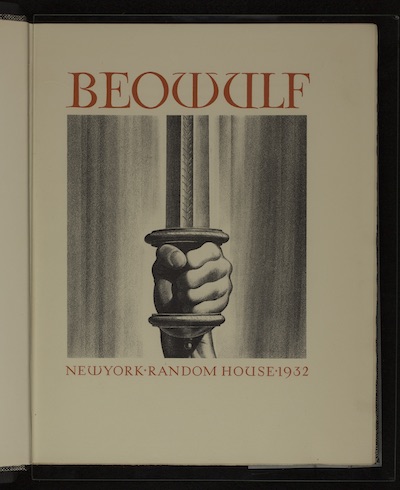
Figure 2.
Beowulf. Illustrated by Rockwell Kent NY, Random House, 1932.
*PR1583 .L55 1932
The American illustrator, Rockwell Kent, had a distinctive “moderne” style that combined geometricized forms with a rugged, even heroic, rendering of his figures. His visual rendering of the legend of Beowulf in this carefully designed commercial edition added just the right touch for readers wanting new editions of classic titles.
↩
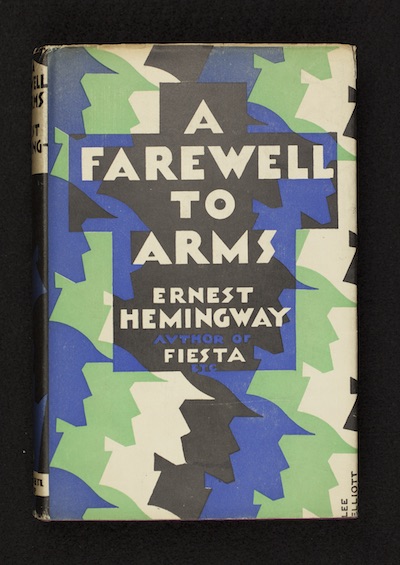
Figure 3a. Ernest Hemingway, Farewell to Arms, . first edition, London, Jonathan Cape, 1929.
PS3515 .H37fa 1929
The illustrated dust jacket on this edition of Hemingway’s best-selling novel makes use of recognizable profile of World War 1 soldiers in their helmets to create a pattern with dynamic movement behind the title, which almost assumes the shape of a cross.
↩
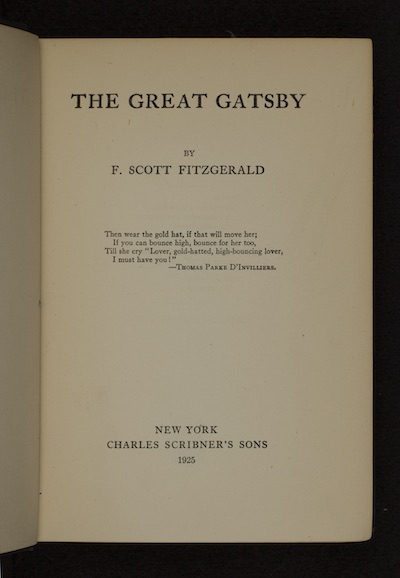
Figure 3b. F. Scott Fitzgerald, The Great Gatsby. NY, Charles Scribner’s Sons, 1925.
PS3511 .F57g 1925
The design of this edition of the jazz-era novel was designed to give it legitimacy. The layout and presentation are without any hint of frivolity, and the text is treated as if it were already a classic, though this is the year in which it first appeared in print from Scribner’s.
↩
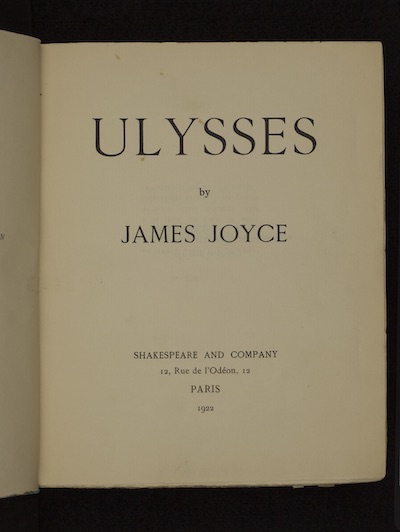
Figure 4.
James Joyce, Ulysses, . Shakespeare and Company, Paris, 1922.
PR6019 .J85u 1922
The controversial book by James Joyce was first published in this edition in Paris by Sylvia Beach, the owner of Shakespeare and Company, who never published another book. The title page is beautifully proportioned and elegantly set in an era when avant-garde typography had become graphically explosive. The decision to keep to a clean, modern, design put the emphasis on the text.
↩

Figure 5.
Vladimir Nabakov, Lolita, . NY, Putnam, 1955.
Sontag PG3476.N11I 1955
The strong, bold, sans serif typography on this cover still references the long printing traditions of using red and black ink. Another highly controversial book, this was first published in France and banned by the censors before being brought out by a major New York publishing house.
↩
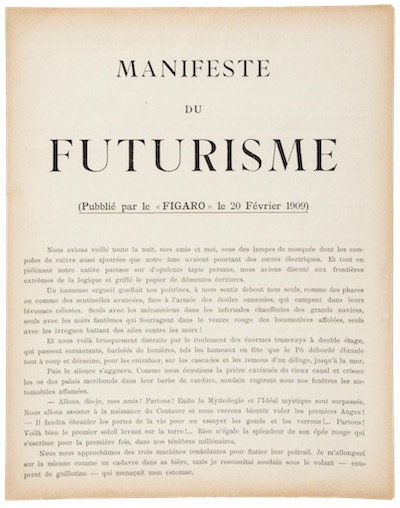
Figure 6.
F.T. Marinetti, Futurist Manifestos, . Firenze, Edizione di Lacerba, 1914.
PQ4087 .M31
The calm appearance of the ”manifesto“ of Futurism, originally published in a French newspaper, Le Figaro, in 1919, does not give much hint of typographic and visual pyrotechnics that characterized the work of the avant-garde movement led by the Italian poet, Filippo Marinetti.
↩
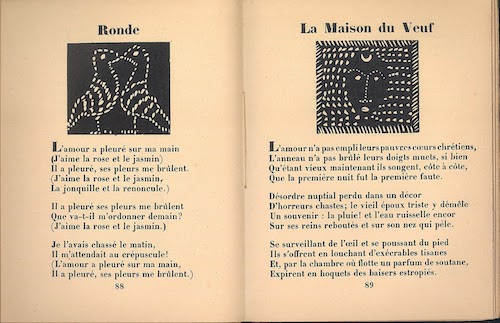
Figure 7.
André Salmon, Calumet, . ornamented with woodblocks by André Derain, Paris, Editions de la Nouvelle Revue Française, 1920.
PQ2637 .S17 C3
Many modern artists were involved in less daring, but still innovative, productions. Small in scale and modest in its production values, this edition of poems was illustrated with original woodblocks by a well-known modern artist. These “deluxe” editions were far from the lavish publications being made at the time as “livres d’artistes” and equally far from the often crudely produced works published by avant-garde artists themselves. The publisher held an established place in modern literature and art.
↩
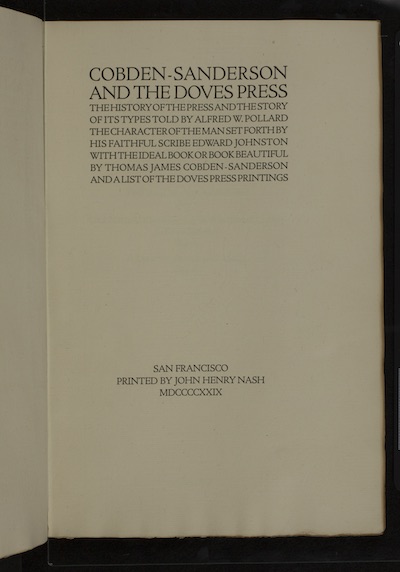
Figure 8.
Alfred W. Pollard, Cobden-Sanderson and the Doves Press, . John Henry Nash, San Francisco, 1929.
*Z232.C6 N1
San Francisco printer John Henry Nash’s loyalty to the refined, rather conservative, aesthetic of the British printer Thomas Cobden Sanderson was evident in his approach to design as well as in the decision to publish a work about the Doves Press. Nash sought an elite clientele through the combination of print quality and very traditional content.
↩
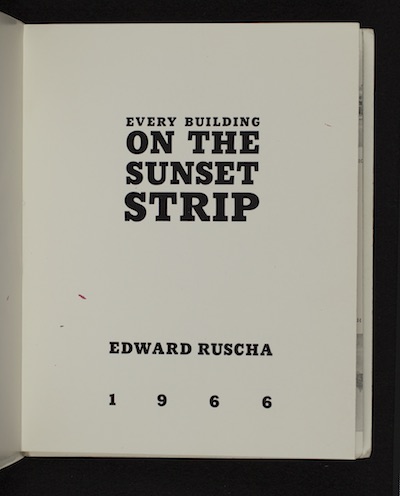
Figure 9.
Ed Ruscha, Every Building on the Sunset Strip,. Los Angeles, CA 1966.
F869.L8 R89
The work of the California conceptual artist, Ed Ruscha, helped to establish a new model of ”artist’s“ book” in the 1960s with publications such as this one, which contains exactly what its title announces—a photographic record of every building on the Sunset Strip in Los Angeles.
↩
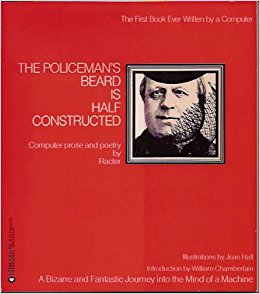
Figure 10.
Racter, The Policeman’s Beard is Half-Constructed, . NY, Warner Books, 1984.
Barcode: B0000473652
This book, illustrated by artist Joan Hall, asserts it is the first book composed entirely by a computer program. The program was written by William Chamberlain and Thomas Etter and the resulting text is engagingly whimsical.
↩

Figure 11.
Michael Joyce, afternoon, . Eastgate, 1990.
No call number
Written using Eastgate’s Storyspace, which was an authoring platform for creating hypertext created before the WWWeb. Issued in CD-ROM, the work offered the reader an interactive experience of moving through linked chunks of text, a concept that was extremely innovative at the time.
↩
All images are from book in the Charles E. Young Research Library at UCLA, unless otherwise noted.